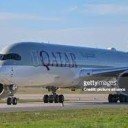Dear IPACS, is it possible to add landing rate monitor to 2024 version ?
Impact with the runway report Rate
-
-
A flight path vector -o- symbol is present in the attitude display of many of the planes, an appropriate descent gradient (allowing for wind) could be followed for every approach. For published ILS glidepath examples in still air follow -2.75 degrees for Oakland 12 and -4.0 degrees for Berne 14. Use shallower gradients with a headwind.
Berne 4 degree gradient using the Flight Path Vector symbol.
A basic starting point 3 degree descent gradient for visual approaches would be about five times the ground speed, so for a fast large transport use -700 fpm for a 140 knots groundspeed.
For a light aircraft use eight times the groundspeed eg. for the Cessna calculate -520 fpm (use 500 fpm) for a 65 knots groundspeed (70 knots indicated airspeed with say 5 knots of headwind) would give about 4.5 degrees, a comfortable light plane descent gradient (well above any Aerofly PAPI angle).
Here the visual Baron with 95 knots of groundspeed (100 IAS with say 5 knots of headwind) would follow -760 (use 750) feet per minute.
Simplify any calculations in your head, for the Cessna example try 2/3 (from 65 knots) of 8 gives approximately 5. Flying consumes most of the brain power.
(Perhaps you mean that you would like an impact with the runway report?
 )
) -

czolgu
December 19, 2023 at 8:12 AM Changed the title of the thread from “Landing Rate” to “Impact with the runway report Rate”. -
exactly
